






|
2007 |
 |
 |
 |
 |
 |
 |
 |
|
Picture of the Week: Self-portrait with wife at the Warsaw airport, last April. Camera: Olympus E-500 Lens: 14-54 mm F/2.8-3.5 at 54 mm Exposure: Aperture priority (-1.3 EV): 1/1000 s at F/4, ISO 100, WB at 5300°K (Sunny). Postprocessing in Photo-Paint: slight tonal adjustment and sharpening, 5% crop. (Click on the picture to see it in higher resolution.) |
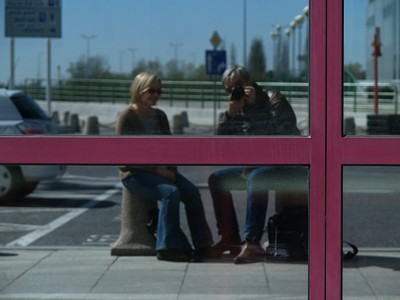
|
|
The most unique ZD lens so far? For the last two weeks I've been using the 7-14 mm F/4 ZD wide-angle zoom, and I really, really like it. First of all, this is the widest rectilinear (as opposed to fish-eye) lens for any system less than full-frame (and we know what those cost!), zoom or not. Second, it delivers: the image quality is most impressive. |
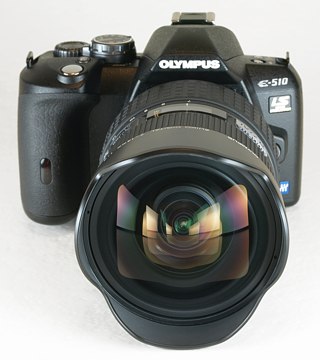
|
While the $1600 price may seem steep, if you need a real wide angle and outstanding optical quality, there is simply no other choice, Olympus or not. Well this lens may be (and for some is) enough of a reason to get a Four Thirds body, even if you're happy with (and/or invested into) another system.
My |
|
Popular Photography strikes again. Every year the technical literacy of writers reaches a new low (except for Mr. Keppler, always fun and educational to read). In the January issue, the reviewer writing about the new Panasonic DMC-L10 (a Four Thirds camera) mentions the Olympus E-510 as having an advantage of "a wider variety of compatible glass". I'm not sure how this conclusion was reached — if every Four Thirds lens works with every Four Thirds body. This may have something to do with the "new math" and our school system. Still, Popular Photography remains our sole source of real, dependable lens tests, so I'm going to keep my 25-year old subscription. And I like reading something printed on paper. A conclusion of my laptop saga: After a month (!) of having it in their repair shop, Averatec still did not have a replacement motherboard, which is somewhere between outrageous and pathetic. I decided to accept a partial refund, and got myself an Asus U6S-A1, one of the very few models combining portability (12" screen) with processor power (Core 2 Duo T7500 at 2.2 GHz). A beautifully made and well-performing piece of hardware, crippled with the Windows Vista. This is the first Vista-based system I have, and it looks like Microsoft outdid themselves this time in screwing things up, royally. Before I started using it, I was taking all user complaints with a grain of salt, but no longer. The thing uses 50 MB of memory just to show the glassy Aero interface, another 30 MB for the gadget sidebar; to see an empty desktop with no applications running you need close to one gigabyte. The security "improvements" make any file operations close to impossible, or at least most irritating, and wireless networking is almost broken. Let me spare you the details, but I've been around the block a few times, and I have no doubts making these statements, as strong as they may seem. A friend at work (also a software engineer and IT professional) gave up after three weeks, reverting to Windows XP (more money for Microsoft, what a business model!); I'm planning to hang around and see what happens. In the meantime, I'm still under a huge email backlog; do not feel offended if I sometimes reply with a two-month lag. As always this time of the year, I'm off for Poland; back on January 6th; do not expect much, if any, activity around here before then. Merry Christmas (or, as Washington Post wants it, "winter holidays"), everyone! We had some photogenic weather on the Thanksgiving Day afternoon: the last twenty minutes of scattered, warm sunlight before an approaching storm. A quick walk around my neighborhood brought a number of keepers. Here is one. While the original, color picture was quite nice, I decided to play with it a bit in postprocessing. Converted to monochrome (red-filtered) the picture was OK, but I decided to run it through the faux-infrared filter in the latest Paint Shop Pro X2, and here is the result. |
|
The new Paint Shop Pro X2. I've been using this program since early Nineties, although not for photography, but mostly for Web graphics (and an occasional business presentation). A few weeks ago Best Buy was selling it at $50 (compare that to $60 Corel charges for the upgrade from the previous version, or $100 direct), so I decided to get the new version. I hope to do a brief photographer's write-up of that program within the next month; for the time being let me just say that there are many things I really like about it (fewer bugs that Photo-Paint, less repulsive to use than Photoshop, while every bit as capable, at least for my needs) and a few I still dislike (speed of operation, crude sharpening algorithms); still, after some effort spent on mastering and, as importantly, customizing it, Paint Shop Pro can really shine as a postprocessing application, and not just at the price. True, PSP X2 it is still bloated with features useless for a photographer (vector graphics? picture tubes?), at the same time skipping some of those we may consider more essential, like Olympus raw camera file support. The product information is evasive on the subject, stating here: "IMPROVED Camera Raw Support | Download photos from camera to computer effortlessly -- including Raw". Seriously, I'm not joking (maybe Corel is?) — this as all I was able to find on the Corel site (in addition to a 2005 Knowledge Base article, listing E-10 and E-20 as supported models). While I was able to open (in 16 bits/color) an .ORF file from the E-500, the program reported such a file from the E-510 as "unsupported type". Yes, I'm using the latest v12.01 update, released in mid-November; actually, the E-500 support was fixed only in that version — just after the camera went out of production. Not a promising sign. Still, at $50 the PSP X2 is a good buy for what if offers, and it has at least four features I need which it does better than other programs I've used. For the record: the official product name has been bloated to "Corel Paint Shop Pro Photo X2" — a clear sign of some marketing specialists working really hard. The next version may be named "Corel/Adobe Paint Shop Pro Super Photo PS3 Plus" or even better. What happened to the Olympus raw file plugin? RIP? Yes, it seems so. This handy piece of software allowed you to import (with adjustments) a raw Olympus (.ORF) file into your favorite image-processing application, as long as it supported the PhotoShop import plugin standard (and all better ones do). Unfortunately, the last version available included compatibility with models up to the E-500; nothing after that. The way things are, for the E-410, E-510 or E-3 you have to use the Olympus Master (good looking, clumsy, limited), or Olympus Studio (still limited, not really an image-processing application), and then save the RGB image (preferably in a lossless, 48-bit TIFF format). Only then you can load it into a "real" image editor. Hardly a smooth workflow. Ironically, both the Master and Studio give you, at least in some aspects, less flexibility in conversion than the camera's firmware. The same is true about the third-party raw-to-RGB conversion programs and plugins I've seen. Were the raw plugin still alive, the missing .ORF support in the PSP X2 (or other similar applications) wouldn't be a problem at all. Oh, boy, am I happy not using the raw format! If I were, I would be really grumpy now. (And yes, I've tried the LightRoom from Adobe, and I'm suffocating in it.) |
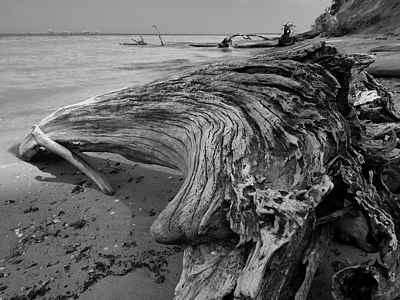
|
A new Gallery page:
Calvert Cliffs — some monochrome pictures from one of the Maryland state parks.
Monochrome? Yes, many subjects look better this way, and I'm often forgetting about that (what about you?) Besides, I wanted to try out the monochrome conversion tool in Paint Shop Pro X2 (very nice!), in addition to the faux-infrared effect (also nice, but easy to overuse). Olympus E-500, 11-22 mm ZD lens at 11 mm; aperture priority (-0.7 EV): 1/160 s at F/9, ISO 100. Sharpness N-2, Contrast N-1. Monochrome conversion in Paint Shop Pro X2 (red filter simulated). |
|
Dark Noise and Hot Pixels in the E-510: the article, posted just yesterday, has been updated by adding a comparison with the E-500. Yes, the new model has a clear advantage here over the older one. No, it is irrelevant in most applications. To all my Readers in the States: Happy Thanksgiving! | |
|
My laptop is still in repair: last week Averatec diagnosed a need to replace the motherboard; five days later they told me the motherboards (for a current model) are out of stock, and they will have to reorder. Excuse me? Will have to? Five days after discovering you are out of stock? In a nation-wide repair center? Then (three days before the Thanksgiving) they told me the offices will be closed for the holiday, not to expect anything before the break. Is re-ordering an operation requiring three days of uninterrupted attention of a major corporation? Come on, this sound like a bad joke. Averatec makes good and inexpensive computers, but their repair facilities seem to be in need of a major facelift. My email is back and running: I had no choice but to move my backed-up mail folders to another computer; now I'm (again) crawling from underneath a major pile-up. I'm expecting to be current in two weeks or so, not earlier. Dark noise in the E-510. This is the component which mostly defines the noise in shadows of long-exposure images. While it is of minor significance to most photographers (after all, how often do you use a 8-second or longer shutter speed?), some of us just like to know such things. A new article on dark noise and hot pixels offers some samples and comments. It is, of course, also fully applicable to the E-410. Give me a few more days to add a comparison against the E-500; this may be quite interesting. The E-3 is here: shipping in the U.S. for the last few days. I hope to play with one over the weekend. Don't expect a full review, though; I'm not planning to buy this camera, as good as it may be, preferring to stay happily married... Olympus SLR firmware updates. Quite a few E-System cameras got a new firmware, although Olympus Web sites (at least in the U.K. and U.S.) will be the last to announce this, as always. Yesterday I was able to update my E-510 to v1.2, and the E-500 — to 1.2. According to Olympus Japan Web site, the firmware for all E-System models from E-1 to E-510 (excluding the E-400 only) got new versions. The changes are, officially at least, limited to compatibility issues with the new EC-20 teleconverter, except for the E-510, which gains (as per the same source), "Improved image stabilization when shooting at slow shutter speeds". If there are any other changes or fixes, they remain undocumented. It is hard to say how significant the IS improvement may be; to draw any meaningful conclusions I would have to shoot at least 300 test frames, redoing a half of my E-510 IS test. I'm not really willing to do that. For a number of reasons, however, I would guess that the actual improvement, if any, will be limited to a small fraction of EV — unless something was really botched up in the original version, which is quite unlikely. Good news: a firmware upgrade no longer destroys all your presets and preferences, at least not in the E-510 and E-500. Bad news: it is still available only through the Olympus Master (or Studio) software while connected to the Internet. This is a very wretched idea: too many things may go wrong. My laptop failed on November 5, and is now being serviced by the manufacturer. This is why I'm not receiving (or responding to) any email. Yes, I have backed up all data before sending the computer to the shop, but moving my whole email to another computer just for a few days seemed too much of a hassle; I decided to wait it out and pick up where I left. Unfortunately, Averatec is taking its sweet time: it took a full week (since receiving the parcel) just to have a technician open the case. I'm expecting to be back in business within three more days or so, and then I will start working on the email backlog. My apologies, and be patient. Backing up: while I keep an almost-daily backup of my work-related files on an SD flash card, it is nice to be able to restore your whole system to the point where you were before sending your computer to be repaired (most manufacturers will revert your drive to factory defaults). This was made easy and painless by the Macally 2.5" SATA to USB 2.0 enclosure from Amazon, which worked without a glitch. As soon as my laptop is back from the shop, I will as easily bring the drive back to where it was. More E-510 image samples: fall colors and ISO 1600. Yes, the camera is capable of delivering some massive eye candy, and I'm still learning to appreciate it. Leibovitz at Corcoran: A few weeks ago I mentioned the Ansel Adams exhibition at the Corcoran Gallery of Art in Washington, DC. Last week I went back to Corcoran to see the photographs by Annie Leibovitz. Surprisingly, there was a long line for the tickets this time, and the Leibovitz exhibition was much more crowded than the other one. A sign of times, perhaps magnetism of celebrities. In my (layman's) opinion, the Leibovitz exhibition is disappointing. Limiting it to maybe 30% of strongest images would make it superb; unfortunately, the whole set has been watered down by including the remaining 70%, ranging from a "Sears studio" fare (professionally done but uninspired) to plain mediocre (and I do not count the family snapshots, intermixed with the whole). The Monument Valley murals are just a joke (maybe this is really a case, but I don't get it). Still, the few gems (mostly B&W portraits) are memorable and will justify making a trip. Do it if you can. Two new Gallery pages with recent pictures: Maryland Renaissance Festival (shot with the E-510) and What Grows on My Patio (mostly E-510, but also E-500 and E-410). This year my wife and I decided to actually grow something in our patio garden, as opposed to letting something grow. A nice side-effect for a photographer is that you never run out of subjects for picture-taking; during the day the light changes constantly, providing you with endless opportunities to experiment, and during the night various things crawl in. | |
|
In how many different ways can you take a picture of a tomato? Or a moonflower? How do you handle a friendly bullfrog? How good is the bokeh of your new lens? How to set the exposure compensation so that you do not lose detail in red petals? Just get up in the morning, go out, and start playing. Then sip your afternoon gin and tonic, and wait for the sunlight to get just right for that shot of the red pepper. You will find a microcosm of opportunities. |
 Olympus E-510, 14-42 mm F/3.5-5.6 ZD lens at 42 mm; aperture priority (0 EV): 1/80 s at F/10; built-in flash. |
|
Next spring, try to grow something. Anything. The photographer inside you will thank you for this (and you can eat some of that stuff later, too).
Thank you to all who responded to my request and checked how the live histogram works on their E-410 or E-510. Now I can restate with full conviction that the feature is broken and basically useless, as reported in the E-510 review. By the way, the A new article: Picture Modes in the E-510; mostly samples, with some comments. The article is also fully applicable to the E-410. If you live within a driving distance from Washington, DC, or if you are planning to visit before January 27th, it would be a shame not to see the exhibition of photography by Ansel Adams at the Corcoran Gallery of Art, almost across the street from the White House. The exhibition shows some of the best-known pictures by Adams, as well as some I've never seen before. Seeing a four-foot print of Moonrise, Hernandez, New Mexico is just one of many delights. I would recommend seeing this exhibition mostly (if not only) to those who complain they cannot get decent photographs with less than five frames per second, ISO 3200, and image stabilization. Ah, and did you know that your full-frame, 24×36 mm sensor actually has a "crop factor" of 7×? As a bonus, the ticket is also valid for the other display: photographs by Annie Leibovitz; very different and very much worth seeing. Don't miss this opportunity. The E-410 User Report by Ricardo Hernández is here! The editorial work on it took longer than expected, but we are (almost, as always) done. As the camera's imaging is identical to that of the E-510, the piece may be of interest to those who own (or are considering) both models. | |
|
The Olympus E-3 digital SLR, a new flagship of the Olympus line, has been announced with much fanfare on October 17th, with expected delivery date in a month or so. Unfortunately, the few reviews, previews, or hands-on reports offer less information on the camera than the plain official specs. The Hands-On at Popular Photography makes you wonder if the reviewer has actually seen the camera (not to mention used it); so far the most revealing preview can be found at the Imaging Resource. |
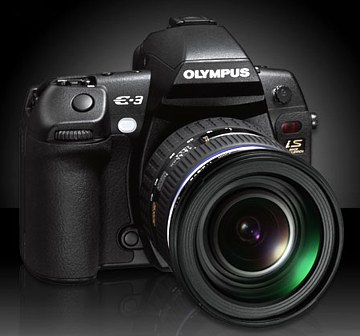 (Promotional image by Olympus)
(Promotional image by Olympus)
|
|
Actually, the best source of information on the E-3 is the Instruction Manual, seemingly in the last stages of the editing process, but 99% complete and very interesting. Bad news: Olympus did not hire better writers. Ironically, the manual does not seem to be available from one of the bazillion Olympus Web sites worldwide, but you can find it at amazon.com. The price? $1700 in the U.S. for the body, an extra $900 for the 12-60 mm ZD ED SWD lens. The most enjoyable season (in Maryland, at least) is here: sunny and warm, yet mild, days just asking you to stay outdoors and take pictures. That's what I'm doing, at the expense of adding contents to these pages; I hope you'll understand. Last weekend my wife and I went to the Maryland Renaissance Festival in Crownsville, just a ten-minute drive from where we live. (Note: the festival will be open on weekends till October 21; if you live nearby, use this opportunity!) | |
|
After more than two weeks with the E-410 I can say that, indeed, this is essentially the same camera as the E-510 — as long as you do not have to have image stabilization. While the latter really works (see my study), its importance is greatly exaggerated. Anyway, the choice between these two models becomes a matter of personal preferences. The hands-on experience with the E-410 prompted me to largely rewrite the original Class of 2007 article, now focusing on similarities and differences between both cameras, largely for the benefit of those who are still trying to make their mind. I've also updated my E-510 Quick Notes. Now I'm focusing on the upcoming E-410 User Report by Ricardo Hern�ndez — the text and samples are ready; what remains is some editorial work and HTML formatting. Another week? Old versus new Olympus kit lenses: finally, I found time to go through my comparative samples, using the E-410 and E-510 in both cases. No doubt: the new lenses resolve more detail, even the 40-150 mm F/4-5.6 — quite a surprise! For the time being just take my word; details and samples will follow soon, I hope. Remember the E-3 floor model auction on a Polish site I reported about? No, the listing did not disappear after all, it is still there, you can see for yourself. Spoof or not, it looks like there were no takers! In the meantime, rumors abound regarding this camera, expected to be announced by Olympus on October 17. I've spent the Labor Day weekend with the E-410 and I have to admit I like it a lot. A few hundred of samples show results undistinguishable from those of the E-510 (and I did some shooting with two tripods side-by-side), and the streamlined user interface is not "dumbed down" as some say; it is actually more elegant and manageable, especially in the menu system, stripped of many options of dubious, if any, value. There only two advantages of the E-510 are larger battery (which results in a hand grip) and image stabilization; the rest is a matter of taste.
I also went through all settings of that camera, one by one, checking the changes and deletions; the result is the new version of my article, now titled Customizing your E-510 Note of March, 2008, added to fix a broken link: this article has been split into two; one referring to the E-500, and one to the E-510/E-410. Old versus new kit lenses: with two almost-identical cameras at hand, I shot a series of comparative samples with the "old" and "new" kit zooms, about a hundred frames with each pair, under identical conditions and within two or three seconds apart. I am very anxious to go through the results, but this will be a full day's work. The floor model of the E-3 seems to have disappeared from the Polish auction listings. Not surprising; this might have been another practical joke. If true, however, this would be a real collector's item, one of a kind, an early prototype. | |
|
News from Panasonic: a new Four Thirds camera, the Lumix DMC-L10, will be available this November. The camera is prominently featured on their Web site, and there is a hands-on preview on DC Review. The L10 seems to share most of the E-410 internals in a somewhat larger body. It does not have sensor-based image stabilization, as this functionality is offered in most of the Panasonic/Leica lenses. (Images captured from Panasonic presentation) |
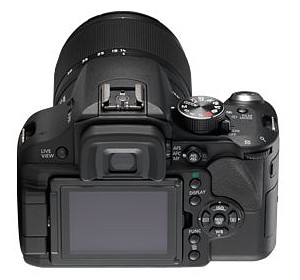 |
|
The biggest differences, at least at the first glance, are in the Live View system: the LCD monitor is articulated (I wish Olympus had this in the E-510!), and the processing circuitry is capable of contrast-detection autofocus off the live preview image. All other features differentiating this camera from the Olympus models of 2007 are also related to the Live View and available in that mode. The camera will be sold as a kit with a new "standard" zoom bearing the Leica logo, the 14-50 mm F/3.8-5.6 Elmar, being a lower-priced alternative to the Elmarit of the same focal length range (see my updated Four Thirds lens list). With this camera (expected to sell at $1300 with the Elmar zoom) Panasonic is aiming at the advanced amateur market, competing directly against the E-510 or the upcoming Canon 40D. I hope it will sell better than the L1, doomed by its brick shape and huge size (it looked good in pictures, but did not sit well in the hand at all). |
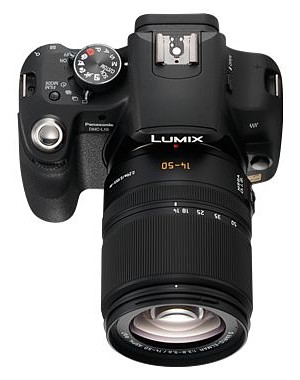 |
|
While Olympus still keeps mum on the specifications of the upcoming E-3 (even the model name has not been announced yet), I've seen one for sale! No, not a pre-order; somebody in Poland claims to have brought from Japan a floor model used on shows, and offers it on the Polish Allegro site (which is a local equivalent of eBay): you may see the listing and it looks genuine. (Jurek: thanks for finding this!) | |
|
I've ordered an E-410 for a friend, and it just arrived. I will keep it for a while to check it out, hoping to do a full review: after all, this camera shares so much with the E-510 with which I'm quite intimate. At the same time, a a new contributor to this site has the first version of the User Report done; it will be posted as soon as I'm ready with the editorial work and my comments. | |
|
A cleanup of the whole site (more than 300 pages), but the only thing you will notice (in addition, perhaps, to any bugs introduced) is that all external links (i.e. ones taking you outside of wrotniak.net) are now shown with the small icon, like this one, pointing to, as an example, John Foster's site. | |
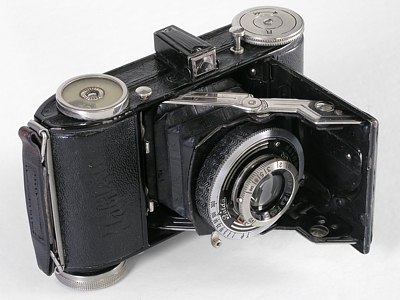
|
During the cleanup I discovered a partly done page on the Balda Jubilette camera of 1938; I wrote some of the text and prepared the pictures back in 2003, only to forget about the work in progress. It was not much time to finish it and add to the Vintage Cameras section, where all other articles also got a minor face lift.
Put your digital SLR aside for a while and have a look. You cannot understand the present, or predict the future, if you do not know the past. |
|
An I on a roll or what? One of the most popular articles on this site has been massively updated: the new title is Customizing your E-500 or E-510, and you can guess why... Note of March, 2008, added to fix a broken link: this article has been split into two; one referring to the E-500, and one to the E-510/E-410. I'm getting confused: just two days ago I've learned that it was Canon who reinvented photography, and today it turns out that it was Nikon after all (does this mean Canon was lying?). Their just-announced D3 (12 MP, 24×36 mm CMOS sensor) and D300 claim, between themselves, such revolutionary improvements like Live View, vibration-based dust removal, and dual card slots. Both cameras should be available in November. Next year we may see body-based image stabilization. More news on the Canon gear front have been announced. First of all, the ultimate professional SLR, the EOS 1Ds Mk.III (expected to be available in November). One small letter, 's', in the model designation means a lot: a full-frame sensor. This is a CMOS unit, as usual for Canon, of their own design and manufacturing, and it sports 22 megapixels, close to what some estimate as a medium-format rendering capacity. Outside of the sensor, and obviously, viewfinder, the camera looks almost identical to the recently introduced EOS-1D Mk. III (no 's'), including the Live View capability. Weight? 1385 g (almost 4 lb) for body only, including battery, but no lens. Price? How about $8000 for, again, body only? This exotic offering aside ("my car brand just won Indianapolis 500"), a more interesting new model is the EOS 40D (expected in September). This one has a 10 MP, APS-C sensor. While it breaks no barriers, it is offering a number of incremental improvements over its predecessor, the 30D. One of these is the Live View, very much like in the Olympus E-330, E-410, and E-510. Actually, here is what Canon says: Previously the province of the EOS-1D Mark III DSLR [...], the Live View function now gives EOS 40D camera users an expanded and exceedingly convenient and comfortable set of shooting options. Interesting... And who invented the Internet, again? | ||
|
Marketing blurb aside, the camera looks very attractive, especially for the existing users of the Canon system. I counted about two dozen things improved from the 30D, and the price point ($1300 body) is, indeed, competitive. What I like a lot is the (moronically named) menu customization system; I would also like to try the editable Picture Styles.
Interestingly, it has a 3-inch monitor (up from 2.5" in the 30D), something I thought was limited to the entry-level models. Well, the same monitor is used in the new 1Ds, so it must be good. |
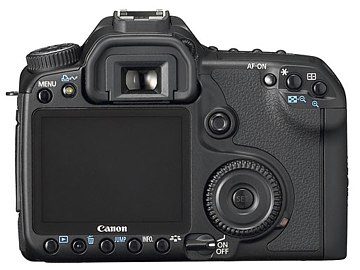 (Image from promotional materials by Canon) | |
|
Risking some controversy, I will say that the most interesting of new Canon cameras is the rangefinder (how else do I call it?) PowerShot G9, expected in September. Having the advanced compact market almost to itself, Canon is not resting on G7 laurels, releasing an updated version of its poor man's Leica, which retains most advantages of the preceding model and improves some other points. The camera has a 1/1.7 (5.5×7.3 mm) sensor with 12 million pixels (why?), and a rich set of features aimed at an advanced photographer who, for some reasons, does not want to use an SLR. | ||
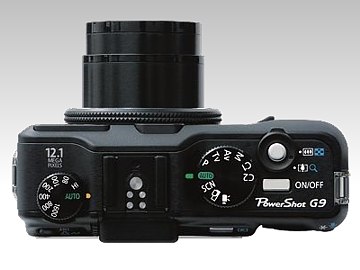
|
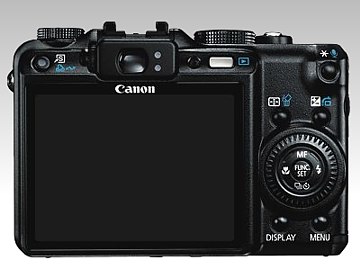
| |
| (Pictures from promotional materials by Canon) | ||
|
The G9 also has the new, 3-inch monitor (compared to 2.5" in G7), probably the same as in 1Ds Mk.III and 40D, with the resolution of 230 thousand RGB sub-pixels (misleadingly referred to as pixels, a common practice; then my laptop has a 3640×800 screen resolution, yeah, right!). None of the these three monitors are, however, articulated, which greatly hampers their usefulness for image preview; the same complaint I have about the E-410 and E-510. Another feature in the G9 is the face recognition technology, with an attempt to use it for focusing and exposure metering. My friend's son tried this feature (on a Nikon camera, that is) with his fraternity buddies during an extended mooning session, and concluded that it has serious problems telling faces apart from the vice versa; forgive me if I'm not posting any samples. Anyway, if this works in the G9, the next step will be Smart Contents Substitution; you cannot stop progress in motion. Back to the Olympus front: my E-510 review has been updated by adding a number of illustrations, mostly those of the camera's monitor (settings, image review, and Live View). | ||
|
With so many people asking about the E-510 image stabilization, I warmed up to dusting off my scientist's hat and doing a small, imperfect, but statistically sound, study of the effect IS has on images from the E-510. No, I'm not going to give out the numbers here, as quoting them out of context might do more harm than good. Read the full article, or refer to anecdotal evidence available from so many sources. Oh, and thanks to all of the Readers who submitted corrections, extra information, and suggestions for my recent articles related to the E-510. Remember: every little thing helps, even a fixed typo! I am done with the E-510 review. This means that no important parts are missing, and I said what I wanted to say. Ambitious claims and specifications aside, it took me three weeks and 2100 frames to get a grip on this camera's imaging capabilities, and to fully (?) appreciate this little beast. Now I can honestly say: I'm a skeptic convinced. If you want just a quick opinion without detail, jump straight to Conclusions. This is the biggest article on this site so far: at 190 kBytes of text it surpassed the write-ups of the E-500 (130 kB) and E-300 (120 kB). Are cameras getting more complicated, or am I becoming more verbose?
Of course, the image samples. Some are quite impressive, and I included many full-size, original files (got lots of bandwidth to burn, why not?). These are split into two articles, appropriately named More on infrared: the article on E-510 in infrared has been updated with a section on handheld infrared shooting. Why not? With working image stabilization and IR-usable ISO 400 I was able to get about 50% of frames without a blur, even using the Live View (and this is much more shake-prone). Shutter speed? How about 0.4 of a second? In the meantime, my Slik U-112 tripod died: the bottom of the nut-holding chamber broke. I've been using this tripod since 1984, and it never failed before. Finding a replacement was not easy, but after some Internet research and trying ten or so models at a local Ritz Camera store, I settled on the QSX 9001 made by Sunpak. At 1.5 kg this is the heaviest tripod I can carry and the lightest one I can use. We will see. | |
|
Not much progress, but a thorough cleanup of the E-510 review; I need a full weekend to move things ahead here. I was, however, able to put together Infrared Photography with the E-510 — it may, indeed, be the best digital SLR yet for this purpose, short of a $400 custom job (or the exotic Fuji UVIR model). The Olympus E-510 review is here! Warts and all, in a very early, imperfect version, with a few pieces still missing, but the main backbone of the article is ready. At this time I'm still afraid to draw any clear-cut conclusions, and this is one of the missing parts. If you want to see the completed piece, wait for two weeks or so; if you cannot wait — have a look now and come back later. One of the problems when writing it was that the camera's operation is very similar to that of the E-500, in spite of the entirely new imaging pipeline and the new features. Therefore it was very tempting to borrow some of the pieces from the older review, and this is dangerous, as some grave factual errors may slip in. I had to resist the temptation and check every described feature by actually using it: a good four hundred of line items to go through; some took just a minute, others — a few hours. In general, a huge task. In the process I was able to spot some omissions or (still!) factual errors in the E-500 review from almost two years ago. These were filled in or corrected. This is important, as the E-500 is a great camera, very satisfying in use and producing most pleasing results. At current close-out prices, it may be the best buy on the market, so I hope many will benefit from its updated write-up. | |
|
Goodbye to a friend. To all who expressed interest in my E-300 sale offer: thank you for your trust; the camera was sold earlier today to the first Reader who responded, another E-300 user; it is going to his father, a retired police photographer in New Zealand. I'm glad to know my E-300, which never failed me and provides excellent results, will keep doing what it does best: taking pictures. Now I'll be using an E-500 and E-510 (which I already decided to keep) as my basic equipment, with the C-5050WZ still being the best in tabletop photography, even at 2-sec exposures which are a norm with my feeble lighting system. The two SLR bodies I'm using now have almost identical controls, which makes switching between them quite convenient. This is a big advantage. Speaking of the E-510: I continue learning it and working on the technical review; the main text is now 50% ready. This is not just the text, but as I go, I must verify every piece of functionality or specification. Expect the first cut Sunday night; the samples will follow the next week. | |
|
Yes, I dislike lenses which, when held in your hand, feel like they have nothing inside a cardboard barrel. I also dislike plastic lens mounts. Still, in the last few days I've learned to respect the tiny, lightweight, and plastic-mounted 14-42 mm ZD which comes with the E-510 and E-410. Sorry, little guy, for my prejudices: I like the results you deliver, and I like to carry you around, and I'm going to use you a lot when none of my "serious" photographer friends are watching. More on the E-510: it is great to have control over in-camera noise filtering and image sharpening, not having to trust in the manufacturer's choice. And, from my initial research into the matter, it looks like my preferences differ from those by Olympus. Have a look at the first results (100 samples compared) and preliminary conclusions in Noise filtering and sharpness in the E-510, which should be fully applicable to the E-410 as well. When will my E-510 write-up be ready? This is the question asked in almost half of the email I'm getting; at least some people are not willing to depend on concise, easy-to-comprehend (pre-chewed, digested, and excreted) reviews, giving a precise star rating in each of six categories, with a convenient weighted average at the end. | |
|
Looks like some time in August. I want to do it right, and this takes lots of effort and time. It is too easy to write something meaningless or just plain stupid, when a subject is a sophisticated, advanced, and complicated instrument like this camera, with so many options available to the user, and with so many aspects to its evaluation. So far, I'm releasing snippets of information when they are ready, like these from the last few days. In the meantime, have a look at my tomatoes. Olympus E-510, 14-42 mm F/3.5-5.6 ZD at 42 mm. Aperture priority (-0.7 EV): 1/20 s at F/8, ISO 100; Natural image mode with contrast at -1, sharpness at -2, and saturation at -1. Slight postprocessing in Corel Photo Paint. |

|
|
A firmware update for the E-510 and E-410 has been announced, addressing some problems in writing to fast CF cards (I had none with the Sandisk Extreme III and IV). As usual, my first attempt to connect to the Olympus server failed, but I was able to install the update later in the day. Too bad Olympus still insists on providing updates only via Olympus Master a software I don't care much about. The 11-22 mm F/2.8-3.5 User Report is done, although it may still be expanded with more samples, as I've got plenty. The lens is good, but not without minor faults, which should not stop a photographer who needs a solid-performing wide-angle zoom covering more than the 14 mm focal length does. How fast does the new E-510 write its images to a memory card? Mighty fast, I would say. With a $60 SanDisk Extreme IV Compact Flash, it takes just over one second to write a raw image file (and approximately the same for JPEGs); even with older cards it shows a clear speed advantage over the E-300 and E-500. See my updated card writing speed comparison for details. (For all I know, the E-410 should be providing exactly the same performance.)
The smallest shoulder bag for a basic E-510, E-410, or E-500 system: the tiny and lightweight, but quite well-made and generously padded
If you need to accommodate a third lens and/or use larger ones, the slightly bigger In both cases the fit is quite tight and no space gets wasted. And the thing loaded with the basic, two-lens E-510 kit weighs next to nothing. This has been a busy week: I started gaining familiarity with the new Olympus E-510 SLR. With so much hype preceding and following its release, I have to admit I was quite skeptical. You could have noticed I was keeping silent on this subject since the official news announcement last March, suspecting that most, if not all, of the changes from the preceding E-500 (a camera I still highly recommend, and a steal at the current prices!) may be specs-oriented, addressing the concerns and preferences of (most) reviewers and the rest of the box-checking crowd. The E-510 introduces quite a many changes since the E-500, including, but not limited to, a new type of sensor (CMOS instead of a CCD, a huge and possibly questionable choice!) and, obviously, a new image processing engine. All other specs and gadgetry aside, this is what affects your images most, and this may make it or break it for a new camera. The proof is in the pudding. Well, the pudding is here, and so far I'm delighted with the taste. My skepticism (always a healthy attitude) seems to have been largely unjustified. It seems that Olympus has succeeded in a tricky operation: a complete change of the imaging platform (read: sensor class), something comparable to Apple switching from IBM PowerPC processors to Intel. Expect the first, possibly incomplete, version of my in-depth review of the E-500 within a week or two; for the time being you may have a look at my first hands-on impressions, based on a week of using and testing the camera. E-510 and infrared. One of the first things I've checked was how well does the E-510 work in infrared. Not so bad: its effective IR sensitivity is somewhere between the E-300 and E-500; usable with a tripod. My recommended IR auto-exposure compensation for this camera is +5 EV. | |
|
What makes a difference, though, is that with the Live View you are no longer shooting blind (just activate the preview boost and disregard the on-screen exposure indicator; it has nothing to do with the exposure which will be actually used). Actually, lower noise at higher ISO, combined with image stabilization (which works!) may make handheld IR photography possible, if only barely so. I also suspect that setting the camera to monochrome mode can be useful here; for more on this you will have to wait until I investigate the matter further. Please do not ask for details yet. E-510, 14-42 mm, F/3.5-5.6 ZD lens at 14 mm; aperture priority (+5 EV): 0.625 s at F/3.5, ISO 100. Natural color mode, desaturated and tonally adjusted in Corel Photo Paint. |
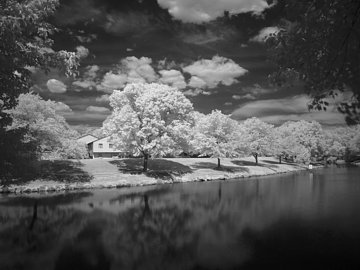
|
|
The canine pictures in this page, posted just a few days ago, prompted some Readers to ask for more, so here is the dog beach gallery (my favorite is, perhaps, the group portrait with the small guy wearing a life vest). All of these pictures were shot with an E-500 and the 40-150 mm, F/3.5-5.5 ZD zoom. It will be most interesting to check how the new, really tiny 40-150 mm, F/4-5.6 compares against that lens. All this caused the review of the 11-22 mm, F/2.8-3.5 ZD lens to be pushed back. Too bad, I already have all the samples, and the lens, while never destined to become a bestseller, is an excellent performer. I regret having to send it to Poland after only two weeks of using it; I suspect I never learned how to get the most of it. A new article, Straight Photography Versus Image Manipulation has been added to the Quest section. Perhaps I should have enclosed "Straight" in quotes? Read and judge for yourself. No, these pages are not being abandoned: simply, I am following my "shoot first, write later" rule. And yes, I've spent the last two months quite busy enjoying photography and mostly disregarding the minutiae of the equipment. While still unable to take the long-delayed trip to the southern Arizona, I made it again to the Ocracoke Island on the Outer Banks, plus the regular share of exploring the Maryland's Eastern Shore. | |

|
Some of the most enjoyable subjects can be found in my own backyard. I just discovered that the city of Annapolis has a dog beach in the Quiet Waters Park, right on the Chesapeake Bay. A good place to grab some snapshots with a long lens (I've used the 40-150 mm ZD): the dogs do everything to delight a photographer.
Set your camera to ISO 400 (to get fast shutter speeds), find a good vantage spot, and shoot a lot! In two sessions I took about 300 frames, of which 20 or 30 are presentable. Olympus E-500, 40-150 mm ZD lens at 150 mm, aperture priority (-0.7 EV): 1/640 s at F/8; contrast and saturation toned down. |
|
On the gear front, I had an opportunity to try out both new Olympus SLR models: E-410 and E-510. I like them both, and will get the latter for myself and the former for a friend before the end of July. My friend fell in love at the first sight with the E-410: it feels good in her small hands, and the limited number of external controls makes her feel less intimidated. She was actually thinking about an EVF super-zoom model, but after having handled the E-410 she wouldn't consider anything else (not even the E-510!). Anyway, expect a User Report on both Olympus models soon. I have also tried the Nikon D-40x: a really nice and thoughtfully designed camera producing good images, but somewhat too limiting for an ambitious user. Still, anyone looking for his/her first SLR should try it out; it is much better than the specs (or most reviews) indicate. The hands-on report on the 11-22 mm ZD lens is almost done. After using it for two weeks to take countless sample images in addition to more casual shots, I may say this is a serious lens. The 11 mm wide end offers a visible gain from the 14 mm focal length of the 14-54 or 14-45 mm models; the image quality at the center is like in the 14-54, and better in corners, and barrel distortion — almost non-existent. While this may be not the first lens you want to buy after getting the "kit" lenses, serious users, especially those shooting architecture and interiors, will appreciate it. Expect the article to be posted within a week or so. My E-300 is for sale! [Note: not any longer, sold.] Yes, I decided to sell this camera, together with its "standard" 14-45 mm ZD zoom lens, at an attractive price of $350 (this includes shipping within the continental US). This will soften the impact of getting the E-510.
If you are interested (serious offers only), contact me via This E-300 was used as my main camera for about ten months (serving as a second body since) and, with less than 8000 frames logged, the shutter has more than 80% of its life left. The body is clean and with no blemishes or malfunctions; updated to the latest firmware version. The original 14-45 mm, F/3.5-5.6 is clean (never used without a protective UV filter, included) and in perfect condition. Obviously, the warranty has expired. In addition to all boxed accessories (except for the plastic hot shoe protector, sorry, but you would lose it anyway within days), I'm including a Quantarray (multicoated) UV filter and a 128 CF card (enough to get you started). Note that the price is below that asked on eBay auctions: I do not want to go through the hassle, and I would like the camera to find a good home (well, at least I do not require you to prove good character and/or morals). I will accept a personal check or a PayPal payment. Sorry, this is limited to the U.S. only. Once again: please, do not take upon my offer if you are not sure the E-300 is the camera you need. I want to sell it to a person who will be happy with it; this is not a blind date.
Any E-10/E-20 users still out there? While I'm on a selling spree, you may be interested in my TCON-300 attachment lens for that camera, in perfect condition (not new, but at least well tested), in the original, padded carrying box. This will cost you $220, including shipping within the continental U.S. (to which the offer is limited). Check or PayPal, serious If you are really interested, I may also decide to sell some of my other E-10/E-20 accessories: TCON-14B (perhaps my favorite), WCON-08B (gets you down to 28 mm EFL), Raynox DCR-FE180PRO (full-frame fish eye), MCON-35 (macro attachment), the RM-CB1 cable release, and the FL-40 flash unit. No, I'm still keeping my E-20, to which I'm emotionally attached... | |
|
Picture of the Week (May 1) The Newark Liberty airport, with Manhattan in the background. Camera: Olympus E-500 Lens: 40-150 mm F/3.5-4.5 ZD at 53 mm Exposure: Aperture priority (-0.3 EV): 1/1000s at F/4.5, ISO 100. Postprocessing: Image manipulation in Corel Photo-Paint: slight tonal adjustment, moderate sharpening. (Click on the picture to see it in higher resolution.) |
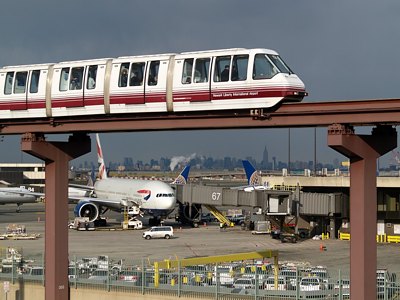
|

|
I'm lucky: my friend's wife grows more than a thousand varieties of bearded irises, and their house is standing on a top of a hill, so that in the late-afternoon the garden has perfect light.
Last Sunday I used an E-500 with the 14-45 mm F/2.8-3.5 ZD and 40-150 mm F/3.5-4.5 to take some pictures, and the results can be seen in the expanded Jane's Irises Gallery page. The bottom half of the page (see notes) contains similar pictures shot three years ago with the C-5060WZ. |
|
Both cameras are in my bag as I'm leaving later today for a trip to the Ocracoke Island, North Carolina (that page badly needs an update; I hope to do that soon). Using the '5060 as a backup has an advantage of small size and weight, and the camera provides results, I dare say, as good as an SLR (or very close). My E-300 stays home: I'm not going to carry two SLR bodies! My Canon A460 User Report is finally done; it took much more time than I expected. While I dislike quite a few things about the camera's controls (first of all: no quick access to exposure compensation and the use of cursor buttons for zooming), the A460 is capable of very good images; something hard to believe at the current price of $120. You may consider buying three and leaving one in your office drawer, another at the back seat of your car, and yet another — somewhere else, for those occasions when you would like to have a camera which you left behind at home. Just in case, check the image samples. Focus bracketing with Sigma lenses on the E-500: Responding to a couple of emails, I've added a section on Sigma lenses to the focus bracketing article. Yes, it works just fine — if you do it right. The article should be also applicable to the new E-410 and the upcoming E-510. New Olympus SLRs: The E-410 is already available in the States, and the E-510 should show up within days or weeks. I just hope they will turn out to be as good as the E-500, which is becoming a great bargain: the two-lens combo can be found at $630. No solid news about the E-1 successor. Yes, I am alive and OK, back in Maryland after the Easter trip to Poland. Not much time to add any new writing here, though: on weekdays I'm quite busy with my Civil Aviation stuff (they used to call that a job), and on weekends I'm occupied taking pictures at the regional wildlife sanctuaries or just on my patio. First things first. | |
|
Last Sunday I made a try to get some pictures of my next-door neighbors: a couple of blue jays. The birds are moving quite fast, usually too fast for an improvised shot, therefore I used a pre-focused camera placed on a tripod, and some peanuts to attract the birds' attention. It worked; out of 16 frames eight were usable (while six were showing an empty space).
Olympus E-500, ZD 40-150 mm ZD at 150 mm
Aperture priority (-.7EV): 1/800s at F/7.1, ISO 400, 5300K Pre-focused, tripod, sequential drive mode 30% crop and sl ight postprocessing in Photo-Paint |

|
|
Web surfing is often just surfing, skimming on the surface. Pages are looked at, like those in a tabloid magazine, not actually read: get quickly the main line of the story and go on. This must be why my April Fools' Day special on geeCam fooled more than a few Readers, generating at least one thread on a discussion forum and quite a handful of emails asking for details or clarification. (The explanatory note at the bottom of the page was easy to miss; I've put it in a small font for a reason.) I wrote that piece mostly for my own entertainment. Dropping more and more unrealistic detail in, leaving a breadcrumb trail to its real nature — enjoyed it a lot. Cardboard lens mount? Why not? George Eastman Kodak? Well, at least some people will find that funny! Parental controls on a camera? Using a blimp to hide "banned body parts"? (These must be some huge body parts!) Reading the text will reveal more of those. Surfing will not. Maybe the article was still too believable, too close to what we might expect from corporations trying to make money by giving away (?) goods and services. But I wanted it to be almost believable: this is required of a good spoof! I might have succeeded beyond the original intent. My employer's comment was "Instead of writing this, you should have applied for a patent". Maybe he is right? Consider the geeCam not just a joke. It is also, more importantly, a commentary on the world we are living in. And there is not much funny about that. "The history of progress ends here, as there is nothing more to improve." | |
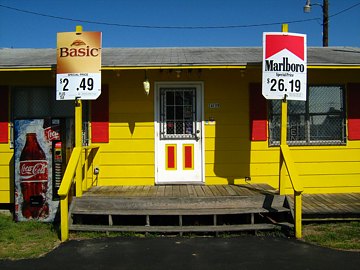
Canon A460, zoom at 5.4 mm (38 mm EFL)
Program (-.3EV): 1/500s at F/8, sunny WB |
Remember my search for an entry-level compact camera for a friend? Finally, I bought for her a Canon A460 ($132 at B&H!), as they are still not available in Poland, and I'm going there tomorrow.
To give the camera a try, last week I took it for a ride from Maryland to Hampton Roads, VA, going for a business trip. Driving down Route 13 in the Virginia Eastern Shore (that's the Delaware Peninsula, for those out of town) you may find quite a few nice subjects to photograph. Here is an example. |
|
First impressions from using the A460 for just more than a week:
If you think you need a better camera because your pictures are not good enough, think again. Over the past week I managed to get quite a few of sample images, so when I'm back from Poland (a week after Easter), I may think of doing a small review of the A460. | |
|
Secrets are impossible to keep in the global village we're living now in. Sooner or later the information leaks to the Web. This time I scored a scoop (with the help of the Altavista's Babelfish translation engine): the photo camera market is going to change — drastically and forever. And this is going to happen within weeks! | |
|
The revolution is based on three new technologies:
These, coupled to the well-proven, context-sensitive Google ad placement bidding scheme and to the existing cell-phone networks, make possible this revolutionary step: the introduction of geeCam, the first free cameras sponsored totally by advertisers. |
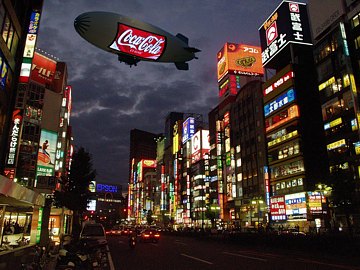
|
|
While the details are still sketchy, three models will be originally introduced, all sharing the same Skeptical? Understandable, so was I. But with all the technical excellence which went into the concept implementation, geeCam's success seems to be unavoidable, even with as little information as we have available at the moment. If you were planning to buy a new camera, do not make any premature decisions until you read my article revealing the whole story: Free Cameras for the Masses. | |
|
It happened: for the last two weeks the Photo News became the most frequently visited page at wrotniak.net. Out of three thousand daily unique visitors to my site, almost five hundred drop by here.
I find it rewarding; this means that the formula introduced a year ago is proving itself. In addition to all the people directed here by Google or discussion groups (who, of course, are most welcome to visit and enjoy what I have to offer), there is also a group who drop by because they already know and like the place, and this page may be the best point to start (at least in my photography section). Thank you, feel at home, and stick around. And, yes, | |
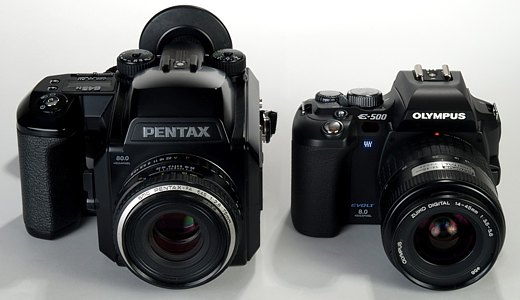 (Photo © 2007 Jeremy Miracle) |
Pixel Peeping Galore, a comparison of samples from the 5 MP Olympus E-1, 8 MP E-300 and C-8080WZ, and the medium-format Pentax 645N (Velvia slide scanned to 80MP).
While such comparisons should not be taken too seriously, our estimate is that the medium format is capable of delivering about 20 (maybe 30) megapixels of useful resolution. (Question: What's wrong with this picture?) |
|
Here is a composite of two 1:1 samples: one shot with the 50 mm ZD Macro, and the other with the 14-54 mm ZD zoom at 50 mm (I hope you can see where the dividing line is). The difference is quite visible. For more on this, see my updated (again!) 50 mm ZD write-up. |
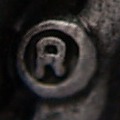
|
|
This adds some extra flavor to the pixel-peeping article listed above. Strangely, most people still talk a lot about the megapixel count, bot not so many — about lens quality. | |
|
With four new articles posted within the last week, I'm afraid I may be neglecting my real life, which I still have. I wanted, however, to clear the backlog before I can spend more time taking pictures outside, and before I take a week-long Easter vacation in Poland. Now we are back to the slow (but steady) pace of adding new contents to this site... What people do after an eight-to-five job on a remote Arctic island? They go nuts — or grab a camera and take pictures. I'm glad Witek Kaszkin chose the latter; here is A Year in the Arctic: an interview and some photographs from his E-300. | |
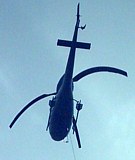
|
Have you ever seen a helicopter like this? This is a fragment of a picture an eagle-eyed Reader found on the Web.
At first I thought it is an effect of the focal plane shutter, see my article of a few weeks ago. Then I checked some numbers — and it turned out that sometimes things are not as simple as they may seem. For your entertainment, I've put the whole story into a small article in my Nitty-Gritty section: How did that happen? |
|
The Olympus Master 2.0 has been released in March. Unfortunately, the Olympus U.S. site is a classic example of Web developers losing control over their creation: the information is scarce, outdated, and incomplete, with the old Version 1.41 being listed as current in most of the places. (The same is true of other Olympus sites; maybe the company should just fire everybody and start their Web presence from a clean slate?) If you are lucky, you can get to the Version 2 page (the link works 50% of the time; probably the server does not cope with traffic), but the Free Download link to the Olympus Emporium seems to be dead or almost so. To make sure this is not some glitch of my browser settings, I've tried that on Opera, Microsoft IE, and Firefox, and on three different computers, including setups with minimum security settings, in case some brain-damaged scripts are fussy. Simple things work best. I do not care about Flash animations, fancy menus, sound and olfactory effects; I do care about the up-to-date and factual contents, logical site structure, and working links. Am I alone in that? Come on, people, focus! Our Hungarian friends from pixinfo.com performed, under as controlled conditions as they could, a test of dust removal systems available in various manufacturers' cameras. In particular, they've checked the Canon 400D (Digital Rebel XTi), Pentax K10D, Sony Alpha A100, and Olympus E-300 (Nikon does not offer this feature). While I would recommending reading the full article, let me just quote the test summary on the system effectiveness, as given by the authors:
This only confirms my theory how this market works: once you add and advertise a feature, the buying public will be happy, regardless of how well it performs. The PMA show is over, and I'm glad it is. Sometimes I'm tired with the manufacturers trying to persuade us that their last year's model (then hailed as the greatest thing since sliced bread) deserves only to be replaced with a new one, putting it to shame. The worst thing is that we often buy that story. As John Foster has put it in one of his recent emails: "Many might argue that the digital camera already signaled the death of photography as we know it by giving its users access to all the technical detritus they argue incessantly about in the photo-forums instead of actually taking photographs." But who am I to cast the first stone? | |
|
Two new articles are almost ready: one is a pixel peeper's delight, comparing the samples from the E-1, E-500, C-8080WZ, and a medium-format Pentax 645 N (that's 80 MP scans!); the other shows some shots from an E-300 which, together with its owner, has spent a year over the Polar Circle, passing the test in spades. To whet up your appetite, here is my favorite: a moonlit beach at the Arctic island of Spitsbergen. Both articles should be posted the next week. |
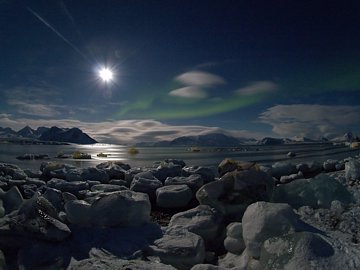 Image copyright ©2005-2007 by Witek Kaszkin |
|
A Web post of my Quest article: Don't Blame Your Camera! — a quick guide to questions and complaints you may hear from friends and relatives. Yes, most often it is not the camera but the photographer... What happened to super-compact cameras? While I was looking the other way, the decent ones just disappeared from the market. My wife's friend needs one, so I had to do some research on this, and here is what I found: zip, nilch, nada. No major camera maker cares about this segment of the market any more; they are too busy making cheap boxes overloaded with mostly useless trinkets. Actually, I was looking for only two features (in addition to small size): (i) an optical viewfinder, as this is more usable in bright light outdoors, and (ii) an easy access to the exposure compensation function (if you have to get into the menu system to apply it, you won't). A lens wider than 35 mm EFL would be very nice, but let us not expect miracles. Guess what: nobody makes a a super-compact meeting my two requirements. The Olympus C-60 (two and a half years old, out of production) comes closest, and the Canon S80 (also no longer available) adds a wider zoom (at the expense of a larger body size). But not a single current model! Ironically, Canon makes some supercompacts with an optical viewfinder, and Olympus — with easy access to exposure compensation, but it would be really nice to have both features on the same camera. A hopeless issue: the popular reviewers just ignore the issue (try to find "Optical viewfinder: None" in a recent camera review), the manufacturers are happy saving $2.37 on each camera they make, and the compact camera market is ignorant enough so that most of the buyers do not even realize they are missing anything. Barefoot and pregnant, indeed. | |
|
If you cannot have it right, at least have it cheap, was my advice, and my recommendation was the Canon A460. It has two advantages: an optical finder (under circumstances I'm not even concerned how large it is), and the right price: it can be bought for less than $140. Unfortunately, adjusting the exposure needs getting into the Function menu.
|
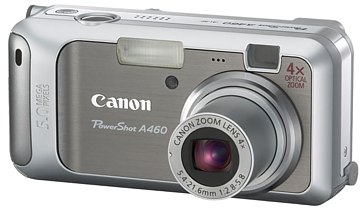
|
|
Oh, well, at this price the A460 can be always discarded and replaced with something better, if such a model shows up. And Ken Rockwell has mostly good things to say about this camera (he is one of the few people writing on cameras who actually take pictures, so listen to the man!) Panasonic made an announcement at the PMA show, about two Four Thirds lenses they already announced last year: "now we are going to sell them to the public". I'm expecting another disclosure at the next show: "now we really started selling them". Oh, well. The third Panasonic/Leica lens disclosure ("now we are working on...") was about the 14-150 mm Vario-Elmar with image stabilization, new ultrasonic motor and lots of low-dispersion glass. I'm more interested in the 12-60 mm ZD; the extra 2 mm at the short end is, for me at least, of more value than the extra 90 mm at the long end.
| |
|
The E-410 and E-510 — a quick look at the Olympus announcement, discussion of the new or not-so-new features, and some initial comments. Nice cameras, both of them, but nothing to be overly excited about. The E-500 is already better than its direct competition, I believe, and these two just push the envelope a bit further with attractive, albeit not really essential, new features. (Image © 2007 Olympus Imaging Corp.) |
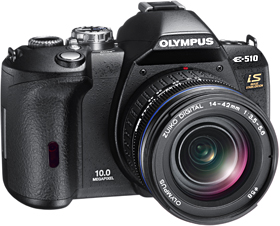
|
|
The E-1 successor has been mentioned without any specific details, as expected to be released later this year. The only meaningful information in that statement was that it will have a live preview.
New Four Thirds lenses from Olympus have also been announced, to be available still in 2007:
Another addition to the system is the EC-20 Teleconverter (2×), but I expect it to be usable only with the premium, high-aperture lenses, as it will decrease the effective aperture by full two F-stops (this can't be helped). Olympus system flashes are now referred to as FL-50R and FL-36R in some promotional materials, without any further elaboration. Like 'R' for "remote control"? |
.jpg) (Photo © Olympus Imaging Corp.) |
The E-1 Successor: Last but not least, Olympus brought to the show a prototype (the actual development progress remains unknown) of the next Olympus professional SLR, temporarily referred to as P-1 (the model designation has not been decided yet). No specifications have been hinted, except for the live preview. Olympus provided selected photo news sites with the pictures showing the prototype; have a look at the DP Review. The camera looks more attractive than the last year's mockup. Noteworthy details: articulated LCD monitor with two degrees of freedom (like in the '5060), built-in flash (in a splashproof body?), detachable (not integral) battery grip, and no mode dial. Aesthetically, the body looks most pleasing, especially from behind, and if only it performs as it looks... Expected availability: Summer, 2007 (really?). |
|
The highlight of today's presentation were, however, two young, sweet and yummy Japanese ladies in assistance. Looks like Olympus is learning how to attract the crowd's attention. Bare midriffs never hurt sales. The 50 mm F/2.0 Macro ZD review has been updated with two more samples; have a look.
French-speaking visitors to this site will appreciate the effort by J-Marc Guillemaut who translated Using Your E-500 into that language and formatted it as a PDF: And no, I'm not going to comment on the E-410 and E-510 until we get the official word from Olympus, with more complete specifications. We are not in the ambulance-chasing business here. Olympus and Ritz Camera making up: Now, guys, shake hands, say "I'm sorry" and be nice to each other. For the first time in years Olympus gear is sold by Ritz, at least online. They are taking pre-orders on the SP-550UZ. The information embargo on the upcoming Olympus SLRs has been broken: the Spanish Foto-Club site shows the first images of the E-410 and E-510, with a handful of specifications, and so does the Polish Olympus Club site, with more detailed images of both the E-510 and E-410 (interestingly, these are stamped with the LetsGoDigital logo, but I wasn't able to find them anywhere at the letsgodogital.org site today). While I am planning a more detailed comparison the next week, after having the full official information and some time to digest it, here are the highlights of the leaked information; features new in these models. The changes in the E-510 specifications, as far as I can tell, are:
The E-410 seems to share all the features listed above, except for the image stabilization, in a smaller body with fewer external controls. For me, the most important change in the E-510 is the move from a Kodak CCD to the new Panasonic CMOS sensor. I'm still not sure how it will affect the color rendition; I'm very happy with the Kodak results, so my doubts are understandable. Still, with the CCD Olympus wouldn't be able to include the Live View feature; this might be the major reason for the change. Obviously, a new sensor requires a new image-processing engine, another unknown. On the image stabilization, demanded by the masses, I'm still skeptical. One more thing which may go wrong. I wonder how it may affect the sensor alignment. On the other hand, I prefer the body-based IS over the lens-based one (where it introduces extra optical elements in the light path, plus a chance to misalign these). More on the E-510: it is quite clear that the camera's body is not just a modification of the E-500 one, but an entirely new construction. The viewfinder eyepiece is more centered now, and the controls, while essentially similar to the "old" ones, have been slightly tweaked. The camera also appears to be better finished (crinkled surface, padded thumb rest) than its older sibling. The finder/flash ensemble is quite different, too. More on that next week. Interestingly, the E-410 will become the entry-level member of the new Olympus SLR line, with the E-510 (priced about €150 higher) as a mid-line offering. According to the leak, both cameras will be bundled with the new, compact lenses, introduced with the E-400. In general, both models include enough bells and whistles to keep the feature-counting crowd happy; let me only hope that they are also capable of delivering image quality for those who care about it. The gossip gets hot about the two new Olympus SLR models which will be announced on March 5. Then we will have to see what new features, if any, are meaningful, and which were only included to keep the checkbox-tickers happy. On the same day we will also know how is the next Olympus pro model progressing. A new article, Going Black and White, has been posted. It was originally published in the Quest newsletter of the Olympus Circle; I'll be happy if it gives you something to think about. My good friend and an avid E-System user, John Foster, has just posted an early version of the E-400 User Report at his site. Generally, John likes the camera (with which I have no direct experience, as it is not available in the States). In addition to his impressions, he is also offering some comparative samples against the e-500. | ||
|
According to John, the E-400 offers a better high-ISO performance (less noise) than the E-500 or E-300, at the same time delivering somewhat sharper images at ISO 100 than the E-500 he compared it against. (I am not sure I'm convinced about the latter; John will be probably adding some AF bracketing to eliminate any impact of possible differences in focus.) In any case, this is, as always, a recommended reading. |
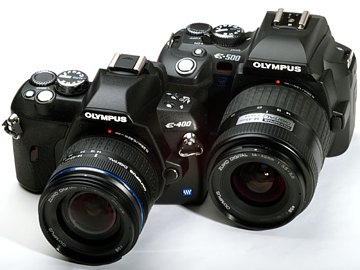 Photo © 2007 by John Foster | |
|
We have a real winter here in Maryland; being snowed-in I've spent some quality time with these pages and strongly reworked the article on infrared photography; last updated almost two years ago. I am also thinking about having my E-300 adapted for this application by removing the antialiasing, anti-IR filter and replacing it with a piece of glass of the same thickness. No digital preview, true, but this would make the camera (which already has the highest IR sensitivity of all Olympus SLRs) much more useful for this kind of work. I'm still not sure if I'm really going to do that; maybe modifying my old E-20 would be a better idea (live preview!); just thinking. | ||
|
A new article: introduction to focal plane shutters in digital (or not) cameras. What was intended as a short note, just a few paragraphs, ended up as a heavily digressed article, including a story of a shot, missed by an 18-year old back in 1912, which later became one of the best-recognized photographs in the history of that medium. Well, I couldn't help it. E-System AC power adapter: for the last few days I've been in touch with Jamie Hamel-Smith, who decided to build a power adapter for his E-500. The effort was successful, and the needed components were (i) an LBH-1 battery holder from Olympus, (ii) a Radio Shack regulated power supply, and (iii) two solder-less wire connectors. The job took about 20 minutes, and you can find all details in a 4/3 Photo forum message thread. Not much new this week, although the Using Your E-500 article has been updated, and some others cleaned up a bit. Next weekend I hope to show you some comparisons between images from the E-500, C-8080WZ, and scanned medium-format film (submitted by a fellow photographer); this may be interesting. Translation from English into English. This is a quote from the Adobe Lightroom FAQ: Photoshop Lightroom software is a new, exciting product built from the ground up for professional photographers. It is an efficient, powerful way to import, select, develop and present large volumes of digital photographs. It allows you to spend less time sorting and organizing images, so you have more time to actually shoot and perfect them. If you would like to know what that means in a language not offending your intelligence, here is my humble translation attempt: Photoshop Lightroom is a new software to import, select, develop and present large volumes of digital photographs. Actually, I've given up reading the FAQ after the third item. Maybe the Google Content Blocker is not such a bad idea after all? (Wait, don't go on, follow that link!) At long last, I'm done with the full review of the 50 mm F/2.0 Macro ZD lens, having used it under various conditions and in various applications. Have a look, it is an outstanding lens, a real performer. From the computer front: I have added a second gigabyte of RAM to my Averatec notebook, see January 15 below. Frankly speaking, I do not need it, even for the advanced air traffic control system I'm often running on that computer; the only application which may actually use it is the Photo-Paint, when processing large images (and this I do mostly on my desktop machine). Still. Speaking about Photo-Paint, the image-processing program with which I have a long-lasting love/hate relationship: the latest Version 13 (or X3) seems to have the memory manager problems fixed (at long last; they started in Version 10 if not earlier). The perspective correction tool, also hopelessly broken since times immemorial, is working now, too; Corel lists it as fixed (or "improved") in the latest Service Pack. (This would mean that nobody at Corel was trying to use this tool for the last ten years or so. When I filed a problem report last year, I've received an automated response telling me to contact their phone support, like this would have helped!) The story of two mice: When traveling to Poland, I took along two infrared, cordless mice, both of the compact (notebook) breed: one by Logitech (V450) and one by Microsoft (Wireless 4000). The Logitech was intended for my notebook; the Microsoft, because of the extra button, for my wife. A friend who tried both liked the V450 a lot and asked me to leave it with him (and buy myself a new one in the States), so my wife tried it out, too. The result was that she claimed the Logitech mouse, and I had to take the 4000 back (no, my friend did not want it!). | ||
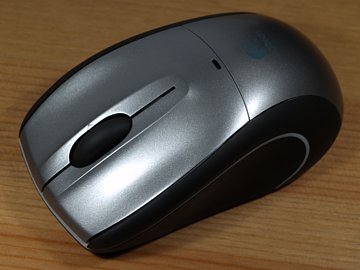
|
Except for looks and price (a $10 difference), Logitech has everything going for it: better double-click, better scrolling, smaller USB receiver (half the size of Microsoft's), smoother ride on a carpet surface.
Frankly speaking, I never realized that two relatively simple, similar products may differ so much in usability.
Olympus E-500, 50 mm F/2 Macro ZD lens; aperture priority (0 EV): 1/15 s at F/8, ISO 100; manual WB at 3000K. It turns out that the incandescent WB preset, while too warm for normal living-room fixtures, is just perfect for the small, adjustable nightstand lights ($7 each) using halogen bulbs! |
|
Olympus SP-550 UZ: this new, electronic viewfinder camera, announced just a few days ago, boasts the widest zoom range on the market, EFL of 28-500 mm, while being almost (if not really) pocketable! What is especially interesting, the zoom starts at 28 mm EFL, not at 35 or 38 mm as most competing superzooms; for me one millimeter at the short end is worth 30 mm or so at the long one; I'll take a 28-300 mm EFL every time over 35-500 mm. Here you do not have to make such a choice. Even better, the maximum aperture changes only by 1.3 F-stops between both ends: from F/2.8 to F/4.5. How did they do it? (Yes, we know: by compromising the optical quality, but by how much?) | ||
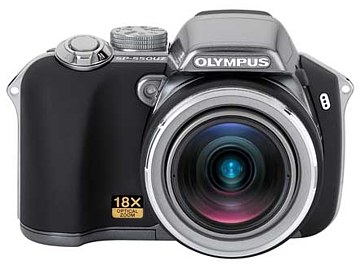
|
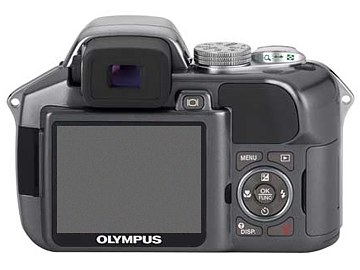
| |
|
Other significant specs include ISO settings up to 1600 (or, with reduced resolution, even to 5000), and, yes, a body-based image stabilization system. Olympus refers to that system as "dual", but the second half of that duality is just raising the ISO setting in lower light; a marketing misrepresentation used by Olympus for some of their previous compact models, as well as by some other manufacturers (who shall remain as nameless as they are shameless). I'm sure the new camera, aimed mostly at the beginner-enthusiast market (this sounds fairly mild, doesn't it?), will sell like hot cakes. Would I recommend it? This is, obviously, hard to say without even seeing (not to mention using) it, but I have some doubts here: there are no free lunches. Putting the electronic finder aside (with an 18× zoom this, sadly, becomes unavoidable), the 1/2.5" sensor packs seven megapixels into an area of 4.3×5.8 mm, and, to quote Tim Meadows as the Ladies' Man, that is tiny! What about noise, image blooming, purple fringing and all size issues? (On the other hand, the '5050, '5060, and '7070 used 1/1.8" sensors, 5.3×7.1 mm, which is not much larger, while offering a very good performance, even in terms of '2007. Who knows; after all, the truth is in the images.) If you would like to see more about this camera, check the preview at Digital Camera Resource. I will have a closer look at it, just maybe, if my wife decides that she badly wants one, and this will not happen before June, if ever. Sigma lens availability: one of the Readers contacted Sigma UK about their Four Thirds lenses: they were announced last year, some even were available for a short time, only to disappear from all stores after a few weeks. The response said, the manufacturing facilities are overloaded lately, and they will be used to make the 4/3 versions only in the very last days of January (which means right now!). I would guess the goodies will start showing up at major retailers mid-February. Oh, well, I've already pushed my Bigma plans to May or even June... More on ZD lenses: check out what some Hungarian photographers have to say about the Olympus "Top Pro" models. Even if you do not want to read the full reviews, see what these guys think about image stabilization and about differences between unsharpness and softness; the latter subject is nowadays being completely neglected. I'm back from Poland, full of traditional Polish food, but with a very few images brought back; actually, I didn't even have to charge or replace the battery in the E-500. The unseasonably warm and wet weather did not entice much shooting; except for the traditional Christmas family snapshots I took only some night pictures at ISO 800 of a new shopping center, in a refurbished 19th century factory complex. Two or three of these may be worth keeping. The bad news is that my FL-36 flash just died. Yes, just like that: it charges OK, the computer circuits seem to work just fine, but it does not fire — either triggered by the camera or manually with the test button. The warranty period ended just a month ago, and the flash was used very sparingly; did anyone experience the same problem? Now, as I am back in Maryland, expect new articles added to the Photo, and the first one will be on the Zuiko Digital 50 mm, F/2.0 Macro lens. Yes, what people say is true: this is one outstanding piece of optics. I was able to check it against the 14-54 mm, F2.8/3.5 ZD zoom — and, indeed, it delivers sharper images, especially in corners; the larger F/2.0 aperture also helps in portrait applications. While I wasn't able to do any portrait work (which is not really my area anyway), I've extensively checked the macro performance, and, again, the lens delivers here. In spades. | |
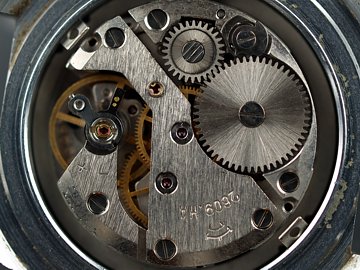
|
I expect to have the first version of the User Report on the 50.2.0 ZD the next weekend; I will also have some remarks on using this lens with the EX-25 extension ring, but that will come a bit later.
Olympus E-500, 50/2.0 Macro ZD lens, tripod, two "daylight" fluorescent light panels. Aperture priority (no compensation): 1/15 s at F/2.8, Note that the bronze wheel at the left is already out of focus; to achieve that, I've used an aperture of F/2.8, just one F-stop from fully open. |
|
There are no new articles this week, but a number of those in the E-System section have been updated; in particular, the ongoing Bigma review got a Who Needs This Lens section, and the article on E-500 customization — a number of small explanations and/or corrections suggested by J-Marc Guillemaut from France. (J-Marc has translated the article into French for a friend; if you are interested in seeing this version posted, let me know.) The rest of today's writing will be about computers; skip it if you are not interested. On my way to Poland, the security line at the Chicago O'Hara airport was longer than I've ever seen; even longer than when you change terminals at Heathrow. When I started placing my stuff on the conveyor belt to be X-rayed, a very busy and very polite security worker asked how many notebook computers am I bringing along: just three this time, all in one slim bag. Whether you want them or not, here are the details. My wife, Agnieszka, is spending the winter in Poland this year, and she needs a computer to store her images, to use for email and for Web browsing. We decided my more than two years old Averatec 3225 will fit the bill, well-configured and set up already. When my HP died in the summer of 2004, I was a bit uneasy buying a little-known brand sold mostly in discount stores, but at $900 I paid, it was hard to refuse. Surprisingly, it turned out to be well-behaved and reliable, and served very well, heavily used for both work and personal applications. (A similar model, 3270, is available at $800 or so, but keep on reading.) As a replacement for my own use, I needed something more advanced, but still with a 12" screen (portability, even at the cost of performance) and, obviously, inexpensive. After some research I settled down on another model by Averatec, the 2370. This one has a 5:8 screen aspect ratio (making it more compact), displaying 800×1280 pixels, a dual-core AMD Turion TL-50 processor, 1 GB of memory (expandable to 2 GB), and a whopping 100 GB of hard drive. Yes, a wireless (801.11g) functionality is also built in (but this is normal these days). At $800 or less, the 3270 is a bargain I can easily recommend for a photographer on a go. It takes me about a month to configure a computer to my liking, including all software to install, but I had plenty of time in Poland. I can already say I really like this computer. It is better made (at least less cheap-looking) than my old Averatec, and the dual processor gives it a snappier performance, even if the clock rate remains unchanged. (This in spite of the fact that most applications I run are not really multithreaded, at least not explicitly; still, most of input/output and some Windows calls are executed as separate threads, and this shows, especially on program startup.) The only thing I do not like in the 3270 is the screen without an anti-glare surface. The last thing I want to see when checking my email in the morning is a reflection of my own face. Take it or leave it, all other models I've recently seen are also missing this feature. A glossy screen looks better at the first glance (read: to someone casually browsing a store), and this may perhaps be the reason. If you are tempted, be warned that this computer has a new-standard ExpressCard accessory slot, not an older PCMCIA one, so that it will not work with any of your legacy PCMCIA cards (like, for example, camera memory card adapters). On the plus side, it is not preloaded with useless shovelware (just some of it, which you can easily get rid of). End of the mini-review, if you need more, see the Averatec Web site or, better, the Laptop Magazine review. The third computer in my bag was for a friend, who has an eyesight problem, so he needed as large a screen as possible — but without breaking a budget. He ended up with, again, an Averatec: the 7160, sporting a mobile, single-core Turion ML-32 processor, 1 GB of memory, and 100 GB of hard drive. The screen diagonal size is 17" (900×1440 pixels, or 5:8 aspect ratio). The whole thing looks rather obscene; it even has a full numeric keypad! (Don't ask me for more on this model, as I haven't used it.) Imagine how refreshing it was to travel back with just one computer, my new, four-pound 2370! | |
 |
 |
 |
 |
 |
 |
 |
| Home: wrotniak.net | Search this site | Change font size |
| Posted 2006/01/30; last updated 2007/12/16 | Copyright © 2006-2007 by J. Andrzej Wrotniak |